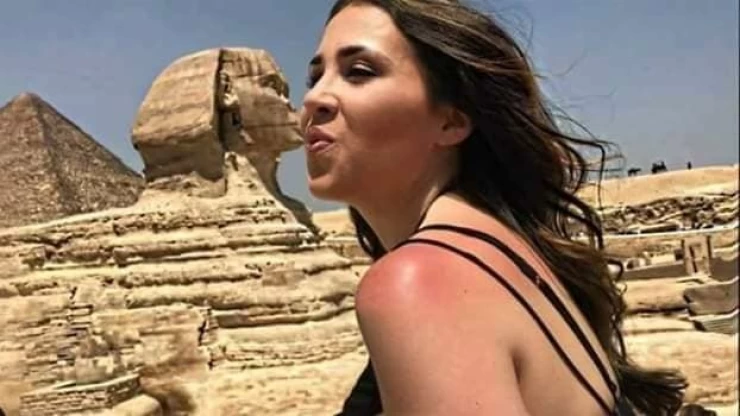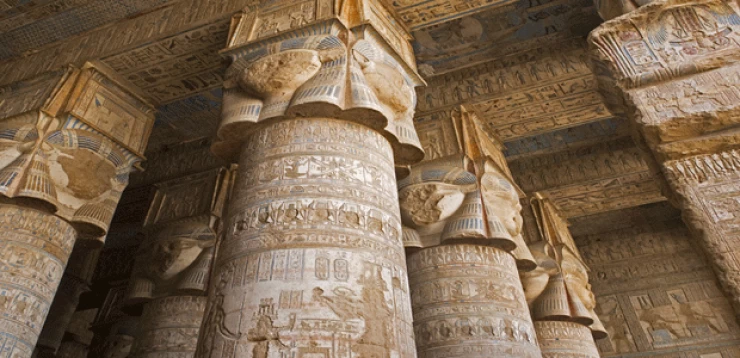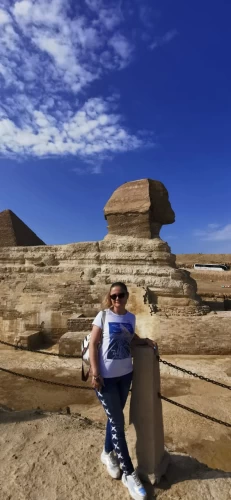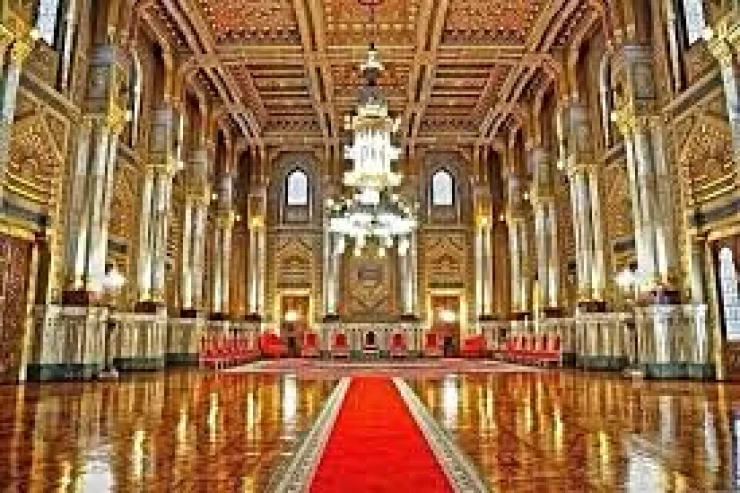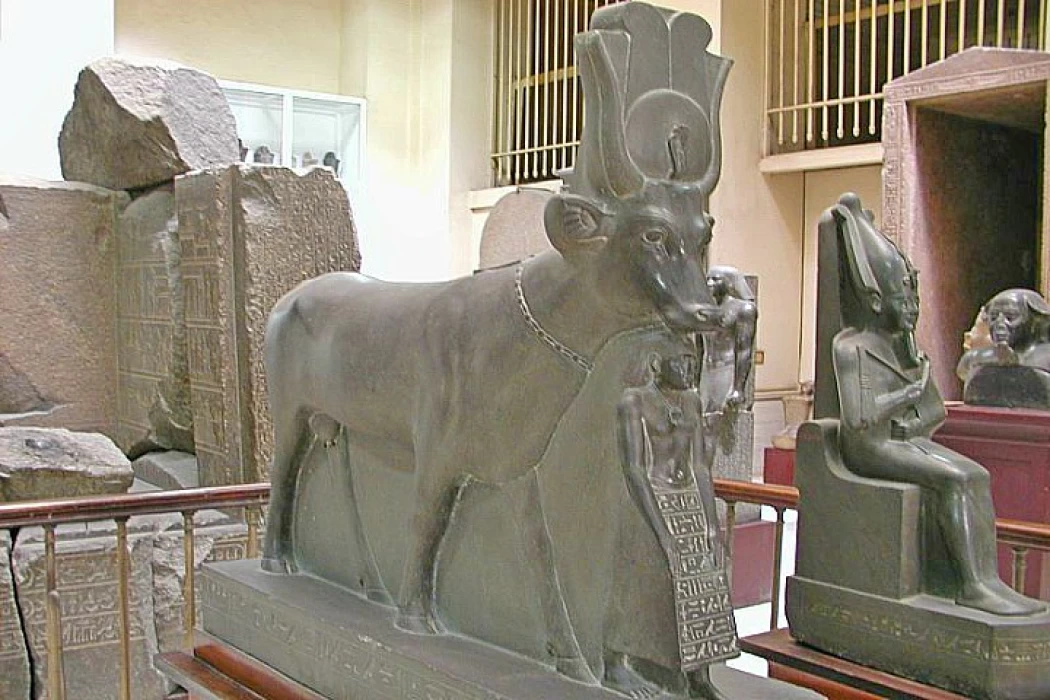
Göttin Hathor | Göttin der Fruchtbarkeit, Liebe und Mutterschaft
Göttin Hathor
Sind Sie vollständig geimpft? Dann müssen Sie bei Ihrer Ankunft am internationalen Flughafen von Kairo keinen PCR-Test vorlegen, um einen einmaligen Urlaub im Land der Pharaonen zu genießen.
Göttin der Fruchtbarkeit, Liebe und Mutterschaft
Göttin Hathor war in der altägyptischen Religion die Göttin der Freude, Schönheit, Musik, des Tanzes, der Poesie und der Liebe. Das heilige Instrument von Hathor war das Sistrum.
Wie in vielen anderen alten Religionen ist auch die Göttin der Liebe die Göttin des Todes (Venus, Libitina, Astarte usw.). So nimmt Hathor auf Befehl Gottes Amun Ra den tödlichen Aspekt der Löwin Sekhmet im Mythos der Zerstörung der Menschheit an.
Ptolemaios Philopator weihte die Nekropole von Deir el-Medina für Hathor. Die Göttin wurde auch in Nord-Aphroditopolis, Apollinofolio Magne und El-Deir El-Bahri verehrt. Sie wurde in Kadesh identifiziert, der Braut von Reshep, einer asiatischen Gottheit, die auch Liebe und Tod bevormundete. Sie wurde auch als Frau von Gott Sobek in der göttlichen Triade angesehen, die in Kom Ombo verehrt wurde.
Wenn Sie planen, Ägypten zu besuchen, sollten Sie unseren ausführlichen Ägypten-Reiseführer lesen, da dies eine einzigartige Erfahrung während der Ägypten-Touren ist, die mit anderen Aktivitäten in Ägypten nicht vergleichbar ist. Sie können eine der klassischen Touren in Ägypten genießen, die alle Reisenden während der Weihnachtstouren in Ägypten oder bei Ostertouren in Ägypten bei bestem Wetter auf dem Nil fahren möchten. Da wir die meisten Tagesausflüge nach Kairo, Luxor-Tagestouren und Assuan-Ausflüge abdecken, ist unser Abschnitt mit Reiseinformationen hilfreich, bevor Sie mit Ägyptens besten Touren für diejenigen fortfahren, die Kultur, Geschichte Ägyptens und luxuriöse Unterkünfte auf dem Nil suchen Senke.
Reisen Sie nach Ägypten, um die ägyptischen Tempel und Pyramiden zu besuchen und mehr über die Mythologie und Hunderte von Göttern zu erfahren, die von den Pharaonen verehrt wurden. Sie waren Menschen sehr ähnlich, die sie liebten und hassten. Sie fühlten sich eifersüchtig und kämpften und starben während eines erstaunlichen Mythos voller Freude. Action und dramatische Ereignisse, die moderne Filmregisseure und Produzenten dazu inspirierten, weltberühmte Filme über die Größe der Pharaonen und der von ihnen verehrten Götter zu drehen. Verbringen Sie ein paar Tage in Abydos, Gizeh, Luxor und Assuan, um die Gräber der Pharaonen zu sehen, die mit sehr klaren, detaillierten und wunderschön gemalten Szenen der verschiedenen Gottheiten des alten Ägypten sowie vielen anderen Orten, Städten, Abenteuern und Dingen geschmückt sind Wenn Sie in Kairo sind, können Sie versuchen, eine unserer Ägypten-Touren und Ägypten-Reisepakete zu buchen. Viele privat geführte Gruppen von Kairo-Tagestouren vom Flughafen und Ägypten-Tagestouren, um die Hauptstadt Ägyptens, Kairo, zu erkunden, können Sie viel Ägypten erkunden Reiserouten oder machen Sie eine unserer kompletten Kairoer Tagestouren wie:
Erleben Sie den Zauber Ägyptens, wo alles beginnt, mit dem professionellen Team von Cairo Top Tours. Starten Sie jetzt Ihr Abenteuer und erleben Sie den besten Urlaub in Ägypten. Sie finden hier die besten Ägypten-Osterangebote und -Urlaube 2024. Der Frühling in Ägypten ist perfekt und die Atmosphäre ist unsagbar schön. Wir organisieren tolle und unterhaltsame Ägypten Ausflüge wie Kairo Tagestouren. Schauen Sie sich unsere Ausflüge und Reisen mit angemessenen Preisen an, die für alle Arten von Touristen im Jahr 2024 geeignet sind, sowie Ägypten Landausflüge, zusätzlich zu Kairo Tagestouren vom Flughafen und Kairo Zwischenlandung Tour. Sie können das antike Theben erkunden, beginnend mit dem Tal der Könige und dem Westufer von Luxor, sowie den Karnak-Tempel und den Luxor-Tempel. Ägypten Touren erweitern, um den Tempel von Edfu von Gott Horus der Falke, und Kom Ombo Tempel und Abu Simbel zu decken. All dies während Assuan-Tagestouren und Luxor-Tagestouren. Das Rote Meer ist einer der malerischsten Orte, die Sie in Ägypten besuchen können, genießen Sie einige Meeresabenteuer und Wanderaktivitäten wie Hurghada Tagestouren und Sharm El Sheikh Ausflüge. Sichern Sie sich jetzt Ihren Platz in unseren Ägypten-Reisepaketen und Wüstensafari-Trips, um von Kairo aus die Oasen Siwa, Bahriya und Farafra sowie die Oasen Dakhla und Kharga zu bereisen! Wir sehen uns wieder.
In the Ancient Egyptian religion, Goddess Hathor was the goddess of joy, beauty, music, dance, poetry, and love. The sacred instrument of Hathor was the sistrum.
She is one of the ancient Egyptian gods. The goddess Hathor was one of the most important and famous Egyptian deities, and even one of the most widespread ever. Some believe that its worship appeared since prehistoric times, while others believe that it appeared since the beginning of the Old Kingdom, on the basis that evidence dating back to prehistoric times and the beginning of the dynasties does not confirm the lineage of Hathor.
As in many other ancient religions, the goddess of love is also the goddess of death (Venus, Libitina, Astarte, etc.). Thus Hathor assumes, by order of God Amun Ra, the deadly aspect of the lioness Sekhmet in the myth of the destruction of mankind.
Widely regarded as the Goddess of Joy, Music, Dance, and Love, Hathor was the personification of beauty, extending her influence through all forms of art to expression. The sistrum—an ancient Egyptian percussion instrument—is revered as her sacred symbol. In ceremonial environments, Hathor worship usually entailed music and dance to indicate her mastery over pleasure and enjoyment. The goddess was a common invocation for women with regard to love, fertility, or protection, as her blessings were believed to nurture and protect both personal and social well-being.
In the fabric of Egyptian mythology, Hathor appears as a symbol of joy and motherhood. She is loved throughout the Nile Valley, and wears many symbolic crowns. She is a nanny and a symbol of femininity. As the goddess of music and dance, her influence moves both heart and body. Its presence in temples and art still exists, revealing its revered role in ancient Egypt.
Like many ancient gods, Hathor also ruled the dead, a particular complement in her complex duality. This dark aspect of her was a deadly lioness, Sekhmet in other words, as her myth enacts: the destruction of mankind. In this myth, Hathor was commanded by god Amun Ra to turn into Sekhmet and punish humanity for disobedience. Therefore, her tale indicates Hathor's duality: a nurturing goddess of life and love and a fierce, destructive one when the equilibrium of the cosmos was disturbed.
Hathor is the house or sanctuary of Horus, according to its interpretation. She is the one who gave birth to the orphan Horus, son of Isis, and breastfed him. Thus, she became a mother to him and to all of nature, as she is a symbol of heaven. Then they made her a shepherd of the dead and settled her soul in the sycamore trees planted near their graves. Then they made her emerge from the branches as a body that sends water and waters the thirsty who have fallen asleep in the pens of death. They imagined that she sometimes roams the desert west of the Nile in the form of a lioness to protect the graves there.
As for the religious rituals and rites held for her, they were most likely established around the Fourth Dynasty, and there is evidence of the presence of male and female priests in many of her places of worship since the Fourth Dynasty at the very least.
Because of her connection to motherhood, then to the god "Ra" and kingship as the mother of the god "Horus", the king, and the daughter of the god "Ra", since the doctrine of the sun became of great importance, she had a relationship with royal rituals and beliefs.
Based on all of the above, her worship expanded to include all of Egypt, and her images and places of worship multiplied in a way that made it difficult to determine her main center of worship; although the most important of these centers was during the Old Kingdom, and perhaps the oldest of them is "Dendera", the capital of the sixth region of Upper Egypt, through which she moved and her worship dominated the neighboring seventh region.
The worship of Hathor stretched throughout Egypt and even beyond her frontiers, and this alone proved her latter-day importance to the religious world of the ancient days. During that era, Sacred City Deir el-Medina was made a shrine of Hathor by Ptolemy Philopator. This necropolis housed the tombs of workers who built the royal ones in the Valley of the Kings and became a prime place of worship of Hathor.
Hathor was known in many forms of worship as the great sky goddess, goddess of love, dance and drink, goddess of the dead, patroness of kingship, and mistress of foreign lands. She was considered a deity of universal nature; therefore, her relationships with many deities were diverse and varied.
She was associated with the sky and the heavenly Horus, and was described as the "Lady of the Sky" and the "Lady of the Stars" as the daughter of the god "Ra". She was associated with both "Isis" and "Osiris", and all the other deities in the form of the cow, and other relationships that are too numerous to list.







